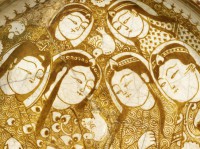Islamic Ceramics trail
Explore over one thousand years of development in Islamic ceramics through our extensive collection.

- This is a visual browsing tool that maps objects in this publication, gallery or collection trail by date of creation onto a timeline.
- The circular markers indicate where objects are on the timeline.
- The size of the markers indicates the relative number of objects at that point on the timeline.
- Hover over a marker to find out which objects are represented at that point in time.
- To expand, collapse or hide the timeline, click these symbols
 found at the top right of the timeline.
found at the top right of the timeline.
- 780
- 820
- 860
- 900
- 940
- 980
- 1020
- 1060
- 1100
- 1140
- 1180
- 1220
- 1260
- 1300
- 1340
- 1380
- 1420
- 1460
- 1500
- 1540
- 1580
- 1620
Blue-and-white ware
From the 14th century onwards, a new type of Chinese porcelain made in the kilns of Jingdezhen and painted in cobalt blue began to reach the Middle Eastern markets in increasing quantity. These expensive and desirable imports stimulated a long-lasting manufacture of local copies, which were steadily produced until the 18th century. From the 15th century, blue-and-white ware played a dominant role in ceramics manufacture in Iran and Central Asia in particular. Close imitations of Chinese originals were produced alongside more inventive interpretations, bringing together Chinese and Islamic patterns and shapes.
 Bowl with vegetal decoration (EA2005.25)
Bowl with vegetal decoration (EA2005.25)
 Dish with flying crane against a floral background (EA1978.1605)
Dish with flying crane against a floral background (EA1978.1605)
 Jar with birds in a landscape (EA1978.1722)
Jar with birds in a landscape (EA1978.1722)
 Dish with quails (EA1978.1783)
Dish with quails (EA1978.1783)
Glazed decoration development
A much wider variety of underglaze and overglaze painted ware seems to have been produced in Iran from the late-16th century onwards. Vessels and tiles were painted with vegetal and figural decoration combining colours and slips under the glaze. ‘Kubachi ware' is a particular type of polychrome ware produced from the second half of the 16th century, possibly in north-western Iran, and named after the village in Dagestan where numerous examples were found in the 19th century. Their use of colour and approach to vegetal decoration indicates some contact with ceramics produced in Turkey in the 16th and 17th century. On the other hand, the figural representations, often in the form of busts, reflect local contemporary painting styles.
 Base of a water pipe with floral decoration (EA1978.1712)
Base of a water pipe with floral decoration (EA1978.1712)
 Base fragment of a dish depicting a man wearing a turban (EA1978.2292)
Base fragment of a dish depicting a man wearing a turban (EA1978.2292)
After almost three centuries of decline, lustre painted vessels enjoyed renewed success in Iran during the 17th century. Lustre was applied mainly on smaller vessels, with vegetal and animal patterns painted on both white and dark blue backgrounds.
A wide range of monochrome glazed vessels in various colours continued to be manufactured during the 17th and early 18th centuries. Among them, a particular ware stands out because of its very fine body, pure white colour, and brilliant transparent glaze. These pieces were mostly decorated with thinly incised and pierced patterns, which emphasised their translucency, with only occasional painting in blue and black.
© 2013 University of Oxford - Ashmolean Museum





